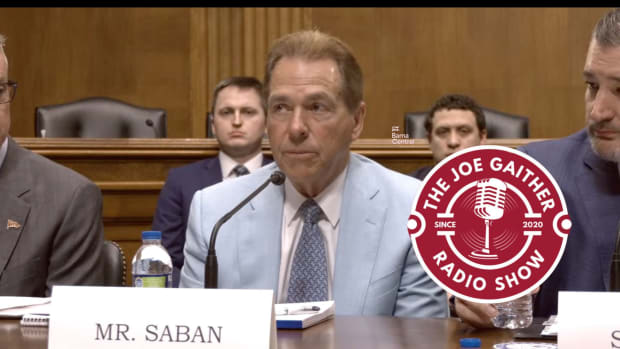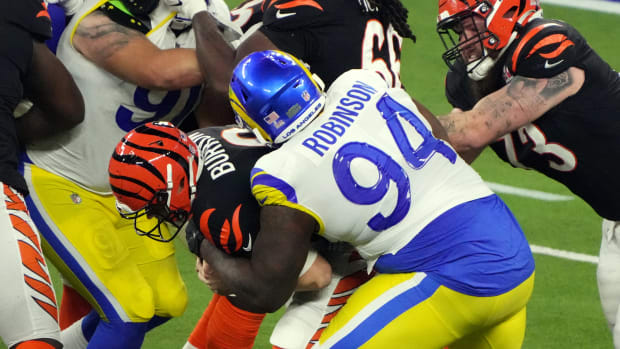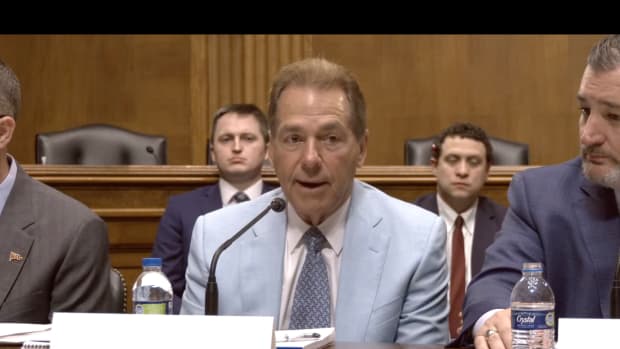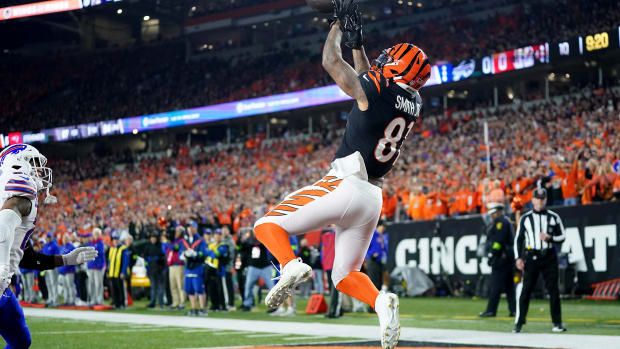For Alabama Thrower, 'BC' Doesn’t Simply Represent His Initials, But Also 'Beat Cancer'
TUSCALOOSA, Ala. — He screamed. Oh, did he scream.
Only it wasn’t just a scream. It was a release. A celebration. A vindication after everything he had been through.
So much pain, and so much joy, all wrapped into one loud expression of emotion. Bobby Colantonio Jr. didn’t even wait for the landing to begin letting it all out, and then couldn’t help but start jumping up and down.
This was on Jan. 31, 2020, the day in which the sophomore arguably went from simply happy to be alive, to making history for the University of Alabama track and field team.
He didn't just have the best weight throw of the Indiana University Relays at Gladstein Fieldhouse at 77-02.75 (23.54m), but shattered the Crimson Tide school record set by Daniel Haugh (75-8/23.10m) during the 2017-18 season.
Ironically, Haugh had probably done it while wearing a BC patch that not only the Crimson Tide sported, but SEC schools and other teams around the nation shared in support.
Bobby Colantonio: Beat Cancer.
Back in August 2016, just after arriving at Alabama at the age of 18, Colantonio was diagnosed with an aggressive form of cancer, and subsequently told that he had about a 20 percent chance to live.
You bet he screamed.
“There’s a couple of things that went through my mind,” Colantonio said about the record. “First, like holy crap. That was a far throw. That was a throw that I definitely wanted to do. But it was definitely above my expectations, kind of.
“That was the first thing. The second thing was like, ‘Hey, I just made this big throw, but I still did stuff, I don’t want to say wrong, but I still had stuff to improve on. The fact that I just made this huge throw, I still have more to go and I have a lot more in me for the season.
“It was like super exciting. At that point, I felt like I was back.”
The Swing
He’ll never forget the moment or the scene, but everything else remains sort of a blur. His father was there. Dad was still in town to drop him off for his freshman year. Yet as one would expect his brain reeled after hearing the word cancer.
“Kids don’t get cancer,” was Colantonio’s first thought, something that would soon be proven wrong in a big way. “It doesn’t make sense.”
But actually, it did make sense, at least after he could take stock of everything he had been experiencing. Nearly all other possibilities had been ruled out by other physicians, and Colantonio quickly found out how extremely fortunate he had been not to have suffered a severe injury.
Colantonio grew up not only with a strong Italian heritage on his father’s side (his mother is Hungarian/Irish), but in a family of throwers just outside of Providence, R.I. His father, Robert, was good. He made the U.S. Junior team in 1979, and his daughter was the first to compete in the SEC at Kentucky.
Bobby didn’t take up the sport until his freshman year of high school, but after his sophomore season gave up football so he could focus on track.
He excelled.
Colantonio was a two-time U.S. junior national champion, three-time junior All-American, two-time New Balance Nationals champion, and four-time state champion in the hammer throw at Barrington High School.
In addition to setting numerous records, he became the youngest U.S. junior champion in the hammer throw as a 17-year-old. Internationally, he placed fifth at the 2015 World Youth Championships in Cali, Colombia, was seventh at the 2015 Pan Am Junior Athletics Championships in Edmonton, Alberta, and also competed at the 2016 U20 World Championships in Bydgoszcz, Poland.
“When we signed Bobby, we knew he was going to break all of our school records,” Alabama track and field coach Dan Waters said. “That wasn’t even a question.”
The pain, though, went back to near the end of his junior year, and over the subsequent summer. Initially there was just a little bit of it in his left knee, and the thinking was it probably had something to do with the enormous amount of pressure being placed on that part of his body.
“That was the start of it,” he said. “That whole year it got exponentially worse. I started to feel pain in my body, other spots as well.”
Colantonio arrived at Alabama weighing 245 pounds and looking like a 6-foot-4 bull who was ready to charge through college. When the subject of knee pain came up during his initial screenings, the track team’s trainer flagged it and sent him to Dr. James Robinson, the head physician for the Crimson Tide athletic department.
Heading over, Colantonio thought the visit would probably be nothing unusual. Instead, it was the start of what he describes as almost being like a beacon from God, a progression of life-changing moments that were more than just right place, right time.
It was like he was being directed, to which Robinson concurs.
The key wasn’t just the pain, but Colantonio also describing the inside part of his knee as feeling like it was always full.
“Sure enough, on exam when I rolled my hand over the area and it definitely felt like there was a mass there compared to the other knee,” Robinson said. “We got the X-ray, and it was very, very subtle. Some changes in the bone.”
Colantonio was later told that they were so faint even most cancer experts might have missed them. However, Robinson had also seen something like it once before, nearly two decades previous with a local high school cheerleader.
An MRI confirmed that there was an issue within the femur. There was definitely a tumor and it appeared to be malignant.
The whole process took about six hours.
Back at the track and field office, Waters closed the doors and the Colantonios and the coaches talked through it. A lot of tears were shed. Everyone’s emotions were all over the place.
And then Robert took Bobby back home to Rhode Island.
The Turn
If Colantonio had osteosarcoma, which is the most common type of cancer that arises in bones and is most often found in people under the age of 25, his story would be much different. The treatment protocol would have been chemo, amputation (and reconstructive surgery), and then more chemo.
“When I got diagnosed, they were looking at amputating from the hip down,” he said.
Instead, he had metastatic Ewing's sarcoma, which often requires more of a whole-body treatment. In addition to the cancer being in the left femur at the bottom of his knee, it was all over his hip, with two spots on the top right femur and four more in his lungs.
According to the American Cancer Society, the overall five-year survival rate for localized Ewing’s sarcoma is 70 percent. Patients with the metastatic disease have a five-year survival rate of 15 to 30 percent.
Due to the nature of the progression, an aggressive treatment was devised. He immediately began chemotherapy at Hasbro's Edwin Forman Pediatric Hematology/Oncology Center.
“It’s hard to describe because you’re just always sick when you’re going through chemo. It’s around the clock, it doesn’t really go away,” Colantonio said.
“The throwing up was kind of aggravating, especially when I was in the hospital, because it was like every hour on the hour. It was all the time, all day. I was on about five or six medications, specifically to not throw up and I would still throw up every hour. It was pretty rough.”
It was even tougher seeing what other patients at the hospital were going through. He saw scores of kids, from infants on up, fighting for their lives as well, many in worse condition than Colantonio. Some didn’t have a chance.
But it was there he started to see the path back.
One of the treatment choices for Colantonio was through radiation if his body started responding to the chemo. It meant taking a bigger chance, yet also meant that, if successful, he could possibly avoid losing most of his femur, the muscle around it, and having knee-replacement surgery.
With a full recovery he might even be able to throw again.
“I had to take that risk,” he said. “It was something that wasn’t even remotely part of the thought process and then it became part of the equation. I had to jump on that.”
Another was being able to take a trial antibody drug conjugate (ADC, intended to target and kill tumor cells while sparing healthy cells), requiring a regimen that would continue well into his recovery and was available at only a handful of hospitals across the nation. One was near his hometown and another in Birmingham, Ala.
Things were coming together like one of his throws, when he can feel the outcome even before he lets go.
The chemo lasted through April.
The radiation ended in July.
“I didn’t know that blood counts could literally hit zero,” he said. “My white cells would be zero, my platelet count zero. … It does take a huge toll.”
In August 2017, roughly a year after being diagnosed, Colantonio, remarkably, was in remission.
The Throw
Sometime in the middle of the summer, the time came to find out if his career was over. Colantonio needed to throw, or at least attempt to throw, and see if that would be the extent of his comeback.
So he and his father went to familiar territory, Conley Stadium at nearby Mount Pleasant High School. It was where both had grown up throwing and had always practiced. If Bobby couldn’t do it, he couldn’t do it. But they had to know.
Colantonio executed the three stages necessary to launch a hammer: the swing, the turn and the throw … and it all turned out to be second nature.
Although the popular belief is that hammer and weight throws are purely strength-oriented events, the technique and form are actually the key, both of which are developed through repetition. His body remembered the routines and nuances of what to do. He was still weak, but otherwise nothing felt different.
“It was amazing to be there, and have fun, and be out there again,” Colantonio said.
The next step was getting back to Alabama. Even though Providence has a strong Italian community and the food to go with it, including scores of hole-in-the-wall pizza joints, he weighed just 180 pounds when returning to Tuscaloosa.
Colantonio could barely lift the bar in the weight room, and it took all semester to start resembling the prospect who had to leave without participating in a single practice.
He wasn’t just starting back from scratch, it was actually worse than that, in rebuilding his foundation, redeveloping his stamina and finding out what his body would allow.
It’s been slow going. Even now, Colantonio, at roughly 270 pounds, estimates that the top throwers in the world can do almost double the workouts.
He doesn’t know how long it’s going to take to get to that point. No one does. But everyone's optimistic he’ll get there.
“And I’m already night and day from where I was last year,” he said.
Meanwhile, Colantonio finally became ingrained with his new team, the one that was supportive and embraced him even when he was in Rhode Island.
“He’s a super good dude,” Waters said. “He’s a team-player. Committed leader. Wants to be really good. He’s extremely loyal, fiercely loyal. Everything you’d ever want in a person and a friend.
“Just a solid guy, all the way around. One of the people who is the foundation of our team.”
That’s why for Waters, the high point of this whole experience was merely seeing Colantonio finally put on an Alabama jersey to compete at the beginning of the 2019 indoor season.
“We always knew he had talent, we always knew he was going to throw far,” the coach said. “It’s just can he get back? Can he get back to putting a uniform on, all clear?”
“He was so nervous,” Waters added about the Blazer Invitational in nearby Birmingham.
At the NCAA level, the weight throw is part the indoor season over the winter, while the hammer is relegated to the outdoor season in the spring.
The former is basically a heavy ball with an attached handle. It weighs 35 pounds. The latter is 16 pounds, but on the end of a wire. It’s the event used in international competitions including the Olympics.
When Colantonio’s father competed, the prevailing thought was to sort of get ahead of the ball and use the torque to your advantage. It was the Russians and Eastern Europeans who figured out that the velocity created had a bigger impact.
“Now the technique is to let the ball do more of the work and you’re more pushing behind it,” Colantonio said. “It’s kind of like when a bike is over on its handlebars and the wheel is spinning. As you try and spin it fast, as it gets faster, if you try and go harder it’ll work against it. But if you just tap it and keep it moving it works really well.”
Consequently, the first meet wasn’t so much a barometer for how far Colantonio had come physically, because he knew he had a long way to go, but in the technical aspects and executing again in a competitive setting.
He nearly hit the automatic qualifier for the national meet with his first series of throws.
Colantonio went on to place 10th at the 2019 NCAA Indoor Championships. A year later he placed first at UAB and was ranked second in the weight throw heading into nationals.
The 2020 championships were canceled at the last minute in March due to the coronavirus pandemic, followed by the entire outdoor season. Normally, Colantonio would currently be pushing himself to his limits to finish strong in June, followed by the Olympic Trials and trying to make Team USA.
The Tokyo Games have been pushed back a year, though, giving him a chance to get stronger and gain more momentum.
“Anything’s possible,” he said.
Nevertheless, last week saw two important milestones for Colantonio.
First, he was named an All-American for the indoor season.
Second, he celebrated his birthday.
Colantonio turned 22. He didn’t do too much, just a little golf and dinner, in part because he has to take extra precautions with the coronavirus due to his immune system having been compromised.
But he views birthdays a little differently now, just like everything else.
“Tomorrow’s not really promised to anyone,” he said.
“It’s really just a miracle that I’m here. I thank God every day for that, trust me.”







